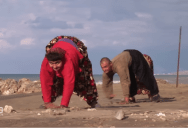Is The Family That Walks On All Fours Proof Of “Backwards Evolution?”

Just when we think we know all there is to know about humanity and evolution – namely that it flows in one direction – a family comes along to challenge everything.
In this case it’s the Ulas family, who live in southern Turkiye. They are unable to read, write, or talk with outsiders, but geneticists and evolutionary theorists are keen to learn more.
That’s because the family isn’t bipedal, like every other human we know of on Earth – they walk on all fours.
The world became aware of this unique family in 2006, but after 20 years of research, we’re not much closer to learning why they walk on all fours.
The family includes 19 children but only a group of 5 siblings seem to have adopted the quadrupedalism. Brain scans have revealed that they share other odd traits, like a small cerebella, impacted cognitive abilities, language deficits, and more.
Üner Tan is the evolutionary biologist who first reported on the family, and he concluded it was an entirely new disorder. He dubbed it “Üner Tan Syndrome.”
He concluded that the “genetic disorder suggests a backward stage in human evolution,” but since then, more researchers have called that assertion into question.
First and foremost, because chimps and other apes, arguably one or two steps backward in our own line of evolution, don’t walk on all fours the way this family does.

Biological anthropologist Liza J. Shapiro said in 2014 that she and her team compared the way the Ulas family walks with other nonhuman primates.
“These erroneous claims about the nature and cause of the quadrupedalism in these individuals have been published over and over again, without any actual analysis of the biomechanics of their gait, and by researchers who are not experts in primate locomotion.”
They found that the family walked with a lateral-sequence gait (left hand after left foot, right hand after right foot).
Quadrupedal primates have a diagonal-sequence gait (left hand after right foot, etc).
In addition, other quadrupedal primates walk on their knuckles; the Ulas siblings walk on their palms.
“We conclude that quadrupedalism in healthy adults or those with a physical disability can be explained using biomechanical principles rather than evolutionary assumptions.”
Sean Carroll, a developmental biologist at the University of Maryland, said the genetics assumed in the initial assessment are flawed as well.
“The interpretation that the members of this family are reflecting some sort of genetic throwback or some sort of ancestral situation – I don’t agree with that interpretation whatsoever. They have a very serious defect in their cerebellum, and they are compensating for that balance problem by walking with the aid of their hands.”
Genetics can’t be at fault for one simple reason, he says.
“There is no single gene for humans walking upright. Walking upright is something that was enabled by the collective actions of lots of genes remodeling our skeleton and musculature.”
At least, not in the way scientists originally theorized.
Defects in the cerebellum are linked to motor disorders, but also autism, vision and hearing problems communication issues, emotional regulation, executive function, seizures, and a long list of other issues.
Also, Carroll points out that we don’t know for sure that the siblings couldn’t walk if given the right sort of support.
“With some assistance they can stand upright. And you can see the other members of the family with the exact same anatomical defect and the exact same genetic lesion have walked upright to some degree.”

Nicholas Humphrey, a London professor, spoke about what happened when they were given proper supports back in 2018.
“Within a few hours it was an astonishing transformation. The simple addition of a walking frame was enough to revolutionize their day-to-day life.”
The children took to it first.
“They had never taken a step upright on two legs, but were using this frame to walk across the room. They had such delight on their faces, and a sense of achievement, and of having suddenly made a breakthrough into a world they never imagined they could enter.”
Researchers now believe their genetic deficits, combined with the remoteness of their home, led to a lack of access to medicine and social programs.
The children simply got left behind because for a long time, the world didn’t know they existed.
“We don’t know why nobody intervened. Why they didn’t do the simplest things they might have done to help them, as would have happened in Melbourne or in London or in New York.”
In the end, it’s more of a sad story than an incredible one.
But at least they have access to the modern world and its interventions now.
If you thought that was interesting, you might like to read about the mysterious “pyramids” discovered in Antarctica. What are they?

Sign up to get our BEST stories of the week straight to your inbox.




